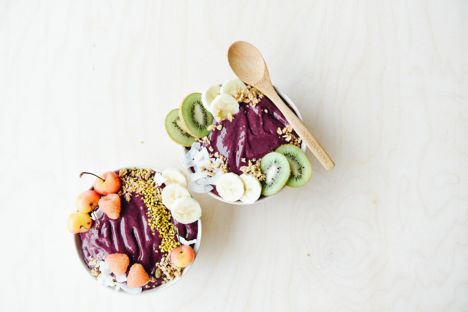
Everything you need to know about açaí
Known for its starring role in smoothie bowls, açaí’s fruity, earthy flavour makes it brilliant in everything from sauces to sorbets. Wondering what exactly açaí is and how to use it? Read on for our introduction to the Amazonian berry.
Everything you need to know about açaí
Known for its starring role in smoothie bowls, açaí’s fruity, earthy flavour makes it brilliant in everything from sauces to sorbets. Wondering what exactly açaí is and how to use it? Read on for our introduction to the Amazonian berry.
If you’ve been scrolling through Instagram over the last couple of years, chances are you’ve stumbled across a picture-perfect smoothie bowl, perhaps finished with rows of sliced fruit and a scattering of nuts and seeds, all atop a layer of vibrant purple. That base would have most likely been açaí, a berry from South America which has exploded in popularity over the last few years. Now at home in bowls, smoothies, drinks and sweet treats, it’s often dubbed a superfood thanks to its high levels of antioxidants and healthy omegas and is also loved for its convenience; as we only eat the skin, in the UK they are usually found blended and frozen, making them incredibly easy to add to dishes.
SAMBAZON has been celebrating açaí since it was founded in 2000 by Ryan Black, who experienced his first açaí bowl while on a trip to Brazil and was keen to bring those flavours back to America. Today, SAMBAZON turns it into everything from ready-to-eat açaí bowls and scoopable frozen açaí and superfruit packs filled with goodness which are ideal for smoothies and bowls. Their ethos centres around giving back to not only farming communities but also the biodiversity of the Amazon – but more on that below. Here, we’ve worked with SAMBAZON to bring you all your açaí need-to-knows, from where it grows to how you can use it.
What is açai?
When we talk about açaí, we’re typically referring to the berries that grow on açaí palm trees. The tall and thin trees reach up to thirty metres in height and are native to the Amazon Rainforest. They grow and naturally thrive along the fertile floodplains, with Pará being a particularly abundant region for açaí. This Brazilian state, located deep within the Amazon basin, is where the majority of açaí berries are harvested. Açaí berries are small and dark-coloured, not dissimilar to blueberries in appearance, with seeds that occupy up to 95% of the berry.
What does açaí taste like?
Açaí berries are slightly tart and earthy – the combination creates a flavour profile which is reminiscent of dark chocolate, red wine and blackberry (cherries are also good comparisons). In texture, the berries can be quite granular, but when they are blended they are very smooth, similar to sorbet or ice-cream.
How do I eat açaí?
As we only eat the skin of the açaí berry (that’s where all the nutrition is) it is commonly found in the UK in the freezer aisle with other frozen fruits. Bowls are one of the easiest ways of using them – the thick, creamy açaí is the perfect base for fruits, nuts, seeds and butters (chef Marcello Tully tops his with banana, granola and honey here), its versatility meaning that it works with everything from tropical fruit to chocolate. Hosting a brunch? Bowls are an easy way of whipping up a dish worthy of a spot on any Instagram feed. Açaí is also a fantastic addition to a smoothie – SAMBAZON has recipes for everything from one inspired by piña coladas to ones spiced with chai. Home cooks also use açaí as an ingredient in rich sauces – think cranberry, apple or even red wine. Essentially, it will find a home in anything that would benefit from its earthy, tart, fruity nature.
How is açai farmed?
Communities living in the Amazon rainforest have long relied on workers to climb açaí palm trees and collect the fruit by hand. Today, that remains the primary method, but increasing demand for the fruit means there are more tools – like pole pickers and harnesses – to make the process safer and more productive. Once they are picked, they are quickly taken to markets to be sold. Then they move onto processing facilities, where the pits are removed, the quality is checked and the fruit is frozen before being sent around the world.
As açaí demand has grown, so too has the importance of sustainable farming, particularly around deforestation and making sure farmers are fairly paid. It’s something SAMBAZON – whose name is an acronym for SustainAble Management of the Brazilian AmaZON – has long prioritised. It is certified Organic and Fair Trade and has a vertical supply chain, which means it oversees every step of the açaí journey, from its wild harvesting to river boat transportation and environmentally-responsible processing. It also gives back to the communities which supply its açaí – its most recent impact report says it has given them over $970,776 (around £766,913.04) in support to date, funding projects and benefitting thousands of people.
Why has açai become so popular?
Açaí long been loved in South America, where the trees’ palm hearts, leaves and bark were also harvested and used for food and medicinal purposes. It was in the mid-1990s that it made its way to Western countries, and since then its popularity has only grown, boosted by the trend for healthy foods which are rich in goodness. Exports from Brazil have risen significantly over the last decade, with the fruit now shipped around the world.
Having found the sweet spot between flavour, health and ease, it’s easy to see why açaí has built such a following. As we get to grips with its potential, though, it’s important we understand where it comes from and, like SAMBAZON, make sustainable choices.


